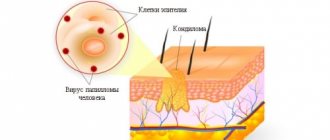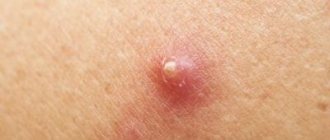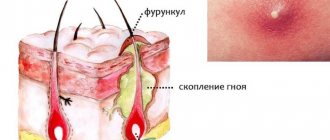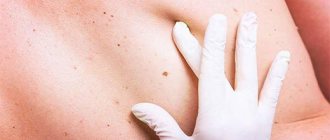The appearance of moles during pregnancy is a phenomenon that affects 60–70% of pregnant women. In some cases, such formations do not manifest themselves in any way, while in others they bring a lot of inconvenience to women. A natural question arises: is it possible to remove moles during pregnancy? There is no definite answer to this question; it all depends on how the nevus “behaves.”
New moles often appear during pregnancy
Why do moles appear during pregnancy?
Pregnancy is accompanied by colossal hormonal changes and the appearance of new moles indicates the body’s efforts to adapt to changing living conditions. An additional role at this time can be played by excess ultraviolet radiation or visiting a solarium.
These formations can be pale pink, brown, even black. They may look like a flat, even speck, or protrude above the surface of the skin.
Most moles that appear during pregnancy should not cause concern; many of them go away on their own after the birth of the child, so doctors do not recommend getting rid of the formation during pregnancy. The question of removal arises if a nevus (as a mole is called in medical terminology) is located in an inconvenient place where it is often subject to injury.
The appearance of moles during pregnancy in itself is not a factor causing concern, but they require monitoring by both specialists and the pregnant woman herself.
Pregnancy is not at risk due to new moles
Reasons for the formation of new moles
During pregnancy, a woman's hormonal background changes. Coupled with exposure to ultraviolet radiation, this provokes increased growth of moles. During this period, old nevi may noticeably increase in size, and new ones appear on any part of the body. But there is no need to worry - they often disappear on their own towards the end of the breastfeeding period.
Most moles appear in the second trimester. Usually these are harmless dark spots that disappear over time and do not deserve close attention.
Although you shouldn’t worry about every mole, you need to know that the reasons for contacting a doctor are:
- Itching and pain in the area of the spot;
- Rapid growth of nevus;
- Redness and peeling of the skin around the mole;
- Discharge of blood or colorless liquid from this formation;
- Changes in the structure of the nevus.
Moles can be very different: from slightly red and small, blue and pink, to large and black. But, despite this, what scares people most is not the dark, convex nevi from which hairs grow, etc., but simple hanging moles. Such moles seem harmless in appearance:
- For the most part they are light in color, pink or white, but can be a little darker;
- As a rule, they are small,
- They resemble small papillae.
However, subconsciously, moles scare everyone, perhaps because of the danger of tearing off such a mole. Hanging moles do not represent anything special that would be worth “clinging to”: they are simple moles formed from the epidermis under the influence of melanin.
The peculiarity of appearance is just a feature of convex moles, which are often classified not only in nevi, but also in the group of papillomas, and therefore it is believed that if a lot of hanging moles begin to appear, then a person may develop the human papillomavirus. In fact, it is impossible to speak specifically and confidently about this; only a doctor can solve this issue, so if you have any questions, you should not try to diagnose yourself; you should consult a dermatologist.
Very often, new moles appear in teenagers and pregnant women. If teenagers are less interested in their health, then a pregnant woman may be disturbed by any change in the body or in the body. So women are very interested in why hanging moles appear during pregnancy. It's all about changes in hormones in the body: at this time, hormonal surges most often appear and are observed, regardless of your goals.
Everyone is interested in what is the main reason for the appearance of hanging moles on the body. However, each person will have their own reason, depending on the specific situation and the characteristics of the processes in the body.
- Hormonal changes. As already noted, hormones strongly influence the formation of new hanging moles. Hormonal levels change greatly, primarily during pregnancy. For this reason, the formation of new hanging moles in pregnant women is not nonsense, but a completely normal phenomenon, which many women know about. Also, hanging moles often appear in adolescents when hormones are “boiling,” and in people who have recently started taking hormonal medications, for example, for medicinal purposes for medical reasons.
- Aging. This is still just an American theory of moles rash on the body. According to her, the reasons for hanging moles on the neck, back, armpits and other parts of the body are that the body aging very quickly and it is necessary to take action. Russian scientists have not yet refuted, but have not confirmed this option for the appearance of new moles on the body.
- Human papillomavirus. To determine whether the rash of moles on your body is really associated with this virus, you need to see a doctor and get the necessary tests.
- Ultraviolet. This is one of the most striking and common reasons for the appearance of moles on the body, not only during pregnancy. For this reason, any dermatologist will give you useful recommendations on how to prevent the appearance of new moles (especially in the summer): in the summer, try to avoid exposure to the sun from 10 to 16 pm, wear closed clothes, use sunscreens or sprays, do not forget wear sunglasses and a hat.
INTERESTING. New hanging moles most often appear on exposed areas of the body that are often exposed to sunlight, especially direct sunlight. Most often, these are the face, arms, shoulders and back.
We are talking about whether the appearance of new hanging moles on the body of a pregnant woman is dangerous. Oddly enough, it is during pregnancy that women notice new or first hanging moles on their bodies. There is nothing strange about this, especially if pregnancy occurs in the summer. The female body changes while bearing a child, causing a woman's hormonal background to change, accompanied by a surge of hormones.
We invite you to read what moles on the back mean
By themselves, hanging moles are just benign neoplasms that can rarely indicate the negative impact of their presence. In fact, a benign mole will not degenerate into a malignant formation if it is not torn off, rubbed, tugged at or touched. However, there is a risk of a harmless nevus degenerating into a dangerous melanoma, so it is worth periodically inspecting changes in hanging moles. Here's what should get your attention:
- The appearance of pain in the area of the mole, as well as when touching it,
- An increase in size of a mole, albeit quickly in a short period of time,
- Darkening or redness of the mole,
- Bleeding of the mole or discharge of clear fluid,
- Itching of the mole, burning inside or around it,
- Formation of a strange spot around a hanging mole,
- A drooping nevus, which looks like a hanging mole turning into a pedunculated mole.
If you observe the same symptoms, you need to consult a doctor as soon as possible, as if you tore off a hanging mole. A dermatologist will examine the nevus and decide whether there is a need to remove this mole, whether it is dangerous and what should be done.
First of all, understand that hanging moles during pregnancy are no worse or more dangerous than simple flat or convex moles. But be more attentive to their manifestations, which will make your life much easier and allow you to relax your nerves.
The neck is a favorite place for moles. However, their danger is that if you forget, you can scratch the mole so that you scratch or tear it off, especially if you have long nails. What to do if you still rip off a mole?
- Be sure to cauterize the mole with a 3% hydrogen peroxide solution;
- If bleeding is observed, then after cauterizing the mole with peroxide, it is necessary to apply gauze or a bandage to the site of injury. Fold the bandage so that it will contain the bleeding. You will have to keep the bandage or gauze on the injury for about 10 minutes;
- If there is no bleeding, simply apply cotton wool soaked in hydrogen peroxide to the injured area, dry it slightly and lubricate the wound with brilliant green;
- Even if there is no bleeding, see a dermatologist or oncologist to check the mole's reaction to injury.
We advise owners of moles in the armpit area to shave more carefully so as not to accidentally cut off a mole. In addition to the fact that this is dangerous due to the degeneration of the mole, you can also introduce infection or dirt, both from the razor blade and from sweat. It is the armpits that are famous for storing bacteria and microbes in large quantities, which can easily get into the wound if shaving improperly.
By the way, for those who accidentally not only scratched or tore off a mole, but cut it off completely, we advise you not to throw away the nevus, but to wrap it in gauze or a bandage and take it to the doctor as soon as possible so that the cut nevus can be submitted for analysis.
Many expectant mothers are frightened by the appearance of hanging moles during pregnancy. As a rule, such formations are small in size and have a pinkish color. They do not pose a threat to your body and appear for the same reason as ordinary nevi.
Sometimes red moles may appear on the skin. This is a sign of a vascular tumor, which is formed from blood vessels. While carrying a baby, not only the balance of hormones in a woman’s body changes, but also the subcutaneous blood vessels. There is no need to worry about red growths. You just need to track changes in color and size. If there is a rapid increase in nevus, then you should consult a doctor.
The papilloma virus that appears on the body of the expectant mother should be distinguished from birthmarks. It appears as a brownish growth on the neck, abdomen or face. Currently, there are no exact reasons for the appearance of papilloma during pregnancy, however, this neoplasm is benign, so you should not pay much attention to it.
Dangerous symptoms
Sometimes old and newly appeared formations begin to change. In this case, you should be seriously concerned, since the transformation of a mole against the background of hormonal changes can threaten its degeneration into a malignant tumor. There are certain criteria by which changes in nevus are assessed:
- rapid and sudden change in color,
- rapid growth and formation of unclear boundaries,
- regular bleeding
- itching, soreness and other unusual sensations.
Such changes can appear both due to internal reasons, with a hereditary predisposition, and with systematic trauma to the mole.
How to avoid the growth and removal of moles
It is unrealistic to predict how a woman’s moles will behave during pregnancy, but you can follow some rules that can restrain their growth during a period of rapid hormonal changes:
- do not rub or comb the formations;
- wear loose clothing;
- avoid direct exposure to sunlight;
- refuse to visit the solarium during pregnancy;
- monitor the development of existing and newly appeared moles.
A woman’s attentive attitude to her health will help stop the development of an undesirable process in time. But don’t panic and try to get rid of moles by all available means. It is better to trust the opinion of a specialist and follow the call of reason.
Where to go
If a woman notices that she has suspicious-looking moles, it is best to inform the gynecologist who is monitoring the pregnant woman. If necessary and if there are any suspicions, the doctor will definitely prescribe an examination and refer you for a consultation with an oncologist.
You should not go to a beauty salon with this problem. Not all beauty salon specialists have sufficient qualifications, and are unlikely to be able to distinguish a darkened nevus from melanoma. And incomplete removal of a degenerated mole leads to its reappearance and a more severe course.
The formations removed in medical institutions are subjected to cellular examination, after which the patient will receive an accurate answer as to whether the mole is a malignant tumor or not. In addition, in case of a positive result, the doctor monitors the woman’s condition, gives recommendations, and conducts a preventive examination.
Only a specialist doctor should examine the tumor
What to do if a lot of moles appear on your body?
What to do if your body is covered with a large number of moles? Moles are congenital or acquired accumulations of melanin on the skin. This is a benign formation, of various sizes and colors.
You may notice that babies are almost always born without moles; after a while it becomes clear that a new amount of pigmentation has appeared, which increases with age, but not in all people. A noticeable increase in the number of moles does not go unnoticed; people note that they suddenly have a lot of pigmentation, which is alarming.
Doctors say this is due to hormonal changes. For example, in pregnant women, there is a disruption in the hormonal system, which results in a significant increase in the number of moles. Also, new pigmentation on the skin is observed after ultraviolet exposure to sunlight.
Factors causing a significant number of moles
For what reasons do new moles appear? Moles are called nevi. Why do they suddenly appear? If there are more moles, then there are reasons:
- the body has undergone hormonal changes (usually hormonal imbalance occurs in pregnant women and adolescents);
- negatively affects exposure to sunlight;
- genetic predisposition;
- a consequence of a viral disease, injury to the epidermis;
- transferring powerful x-rays or radioactive radiation;
- long-healing insect bites.
Scientists have been researching for many years why people get moles. In women, the number of nevi increases after:
- abortions;
- labor activity;
- during pregnancy;
- during the post-menopausal period.
For men:
- testicular diseases;
- failure of the pituitary-hypotolamic system;
- excessive production of estrogen.
Changes in the skin are possible due to stress, infection or congenital defect. Also, the cause may begin during the aging process of the body, especially if it is rapid.
When many moles appear after childbirth, this is the result of restructuring of a woman’s body during pregnancy and labor. Congenital pigmentation is very rare, and most often does not pose any danger.
Nevus removal methods
If it is necessary to remove moles during pregnancy, the method of removal is selected depending on the nature of the formation. If melanoma is suspected, preference is given to surgical removal, since in this case tissue preservation is guaranteed, which allows for a thorough examination of the formation.
Removal of a healthy mole located in a potentially dangerous place can be carried out using a laser beam.
Sometimes a pregnant woman may develop multiple small moles that interfere with her daily life. One of the methods of disposal is cryodestruction - removal using liquid nitrogen.
It should be remembered that any intervention will require anesthesia, which means that the child will be exposed to medications. Therefore, the decision to remove it is made together with the doctor, subject to the existing risk to the mother’s life.
Common myths about moles during pregnancy
Moles are one of those topics among pregnant women that is riddled with many myths. Most of them have no factual evidence and are naive fictions.
- Myth No. 1: If a woman has a mole during pregnancy, her baby will have the same one. For example, if a woman has a mole on her stomach during pregnancy, the baby will also have a mole on her stomach after birth.
Note that during pregnancy, a woman develops many moles that are not passed on to the baby, so there is nothing to fear. The exception is birthmarks that have a genetic basis. However, a woman has these birthmarks from birth and does not occur during pregnancy. In addition, they are ordinary moles that occur against the background of hormonal changes.
- Myth No. 2: all moles that appear during pregnancy are fatal.
There are many superstitions that are interpreted differently depending on the location of the new mole, its shape and color. However, all statements about the fate of moles on the body are not supported by evidence.
- Myth 3: if a woman grabs her face or neck out of fear, the baby will have a mole in that place.
This opinion can be attributed to the realm of fantasy. The entire pregnancy occurs with a lot of fear and stress, which would lead to numerous moles on the baby’s body, however, this does not happen. And cases of spots appearing on the body of children are the result of hormonal imbalances or the genetic predisposition of the little person.
The appearance of moles during pregnancy is a common and completely normal occurrence. But this does not mean that you need to let down your guard. It’s better to play it safe and show the mole to a specialist who will tell you what to look for and how to behave with it during pregnancy.
What is a hanging mole and how to treat it
Hanging nevi occur quite often during pregnancy. Many experts attribute them to infection with the papillomatosis virus, but an accurate diagnosis can only be made after examination and testing.
These formations tend to appear in the most inconvenient places: in the crotch, armpits, under the breasts, on the neck. They can form small clusters, or can reach a size of several centimeters. Most hanging moles disappear in the first months after the baby is born and do not require outside intervention. When it is necessary to “sound the alarm” and draw the attention of a gynecologist to the problem:
- the nevus has reached a large size, affecting the quality of life,
- the mole is subjected to systematic trauma,
- thickening and darkening of the formation,
- pain, itching, numbness at the location of the mole,
- bleeding
Other cases, including aesthetic ones, are postponed until the postpartum period.
Hanging growth is often injured
Why do moles appear in a pregnant woman?
If the doctor decides that the best option for you is to remove the nevus, do not be alarmed in advance. This procedure is performed under local anesthesia and is completely painless. Modern developments in medicine make it possible to remove unwanted tumors in a variety of ways:
- laser removal;
- cryotherapy - cauterization with intense cold using liquid nitrogen;
- electrocoagulation – exposure to high frequency current;
- radio wave removal;
- surgical excision.
The most optimal way to remove nevus during pregnancy is laser removal. It is suitable for almost everyone, except for cases requiring immediate removal. In this case, only surgical excision is recommended, which will allow the affected area to be cut out at one time, eliminating the possibility that the mole was not completely removed.
Laser mole removal in the medical office of Elena Vladimirovna Salyamkina will completely relieve you of the problematic nevus in one or several sessions. An experienced doctor will assess your condition and give full advice on caring for the mole area. The procedure is completely painless and does not even require anesthesia. Within a couple of weeks, the skin will return to its normal shade, and there will be no traces or marks at the site of the former mole.
Surgical excision is done in the rarest cases, only after a positive conclusion from an oncologist. If the doctor does not like one mole being examined, the entire nevus will be removed completely. The woman will also be prescribed medication.
The danger of removing moles lies in the incorrect procedure, which can lead to irreversible consequences. You cannot turn to the services of traditional healers. If you need to remove a mole, do it only in a doctor's office after passing all the necessary tests and under the supervision of experienced doctors. Remember that money cannot buy health. Don't skimp on your family's healthy happiness.
- surgical excision with a scalpel. The safest and most acceptable method for the expectant mother. Can be used for benign and malignant forms of formations. Pain is relieved with local anesthesia. Significant postoperative scars may remain, since the mole is excised along with 3-5 cm of adjacent tissue;
- laser removal. Among the advantages are painlessness and bloodlessness. However, the method is only suitable for eliminating benign nevi. It is impossible to do a histological analysis of the tissue: the mole is completely evaporated. Can be used during pregnancy;
- cryodestruction with liquid nitrogen. Suitable for removing superficial moles only. Disadvantages - the formation of blisters, the inability to examine the removed tissue, long-term rehabilitation. It is not recommended to use during pregnancy;
- electrocoagulation with high-frequency current. A painful method, leaving scars and scars. Only small moles can be removed. Pregnancy is among the contraindications;
- radio wave removal with tungsten filament. Superficial moles are removed and anesthesia is applied. Can be used during pregnancy.
The doctor decides which method to use, based on the potential risks for the mother and unborn child.
Note! The best time of year to remove moles is winter or off-season, when solar activity is minimal.
Removing moles during pregnancy is not advisable. This is explained by the fact that some of them may disappear after stabilization of hormonal levels. This is also due to the unpredictability of the consequences of any intervention in the body. If in normal conditions recovery after surgery to remove a nevus occurs easily, then the expectant mother may experience problems. It is also unknown how such exposure will affect the child.
However, such procedures during gestation are not prohibited. Mole removal is carried out using minimally invasive methods that have almost no effect on the body. During the manipulation, local anesthetics are used, which are considered safe. Therefore, there are no direct contraindications for intervention, and skin growths can be removed.
In some cases, mole removal is necessary. The procedure may be prescribed under the following circumstances: the likelihood of trauma to the tumor, the location of the nevus in the perineal area, a high risk of degeneration into a cancerous tumor.
These situations pose a risk to the health of both the woman and the child. Therefore, it is better to remove the tumor. But the decision about this must be made by the doctor, having assessed the features of the clinical picture.
The formation of moles during gestation is a common phenomenon. Due to the lack of knowledge on this issue, women began to come up with their own explanations for this process. Most of them have not been scientifically confirmed, but are still popular among the population.
Such myths include:
- If, while carrying a child, a mole forms on the body of the expectant mother, then the baby will also have one, and in the same area. There is no evidence to support this opinion. Most children emerge with clear skin without any growths. They begin to form by adolescence, and their location can be any. Although, if there is a genetic predisposition, a similar outcome is possible, and if the mother had many moles, they may appear in the child.
- Based on the location of the nevi, predictions can be made regarding the fate of the mother and baby. This myth is also not confirmed. There is no relationship between skin spots and life events.
- A pregnant woman can cause nevi to appear on the baby's body. This is supposedly possible if, in severe fright, she grabs some part of her body. According to myth, the baby will form a birthmark in this place. But this assumption is wrong. Expectant mothers should not worry about this; in their condition, it is harmful to worry.
Moles on the body are a harmless phenomenon, even if they form in a pregnant woman. This is due to changes in hormonal levels. When it returns to normal, most of the tumors will disappear. Those nevi that remain are also not dangerous if they are not accompanied by pathological symptoms. Removing moles during pregnancy is rarely practiced if there is a threat to the health of the mother and baby.
Related posts:
- Microcurrents for the face: how often to do it?
- Chemical composition of micellar water
- Chemical peeling with fruit acids
- Chemical peeling with trichloroacetic acid
- Chemical peeling medium tca
- Chemical peeling for scars
Why does a mole grow?
The growth of nevus is explained by benign age-related changes in the skin and the effects of external and internal factors on the skin. Oncology in such cases cannot be ruled out either.
As a rule, the following reasons can lead to modification:
- Effect of ultraviolet radiation.
- Mechanical damage to the tumor or trauma.
- Natural hormonal changes.
Ultraviolet irradiation - the change usually occurs after sunbathing. In this case, melanin behaves unpredictably. The growth of a tumor can occur unnoticed, or it can make itself felt very quickly. In any case, its growth causes discomfort and pain.
Trauma - the most susceptible to it are hanging and neoplasms, which often come into contact with clothing or accessories. Damage caused by a razor or washcloth during personal hygiene is also dangerous.
Natural hormonal changes - neoplasms can change their color and increase in size during pregnancy. As a rule, they return to their normal shape and original color after birth.
A nevus may darken when taking hormonal medications. Stimulation of melanin cell growth occurs under the action of a hormonal drug. This is a normal phenomenon if the nevus does not cause physical discomfort.
If, while taking hormones or pregnancy, pain, burning or characteristic itching occurs in the area of the nevus, you should consult a doctor.











